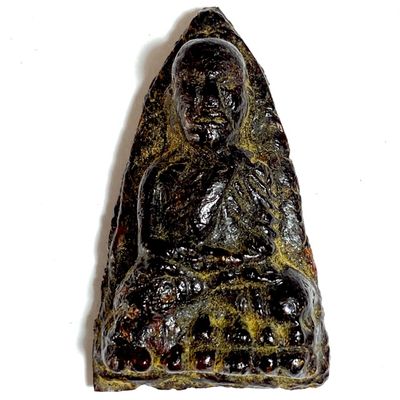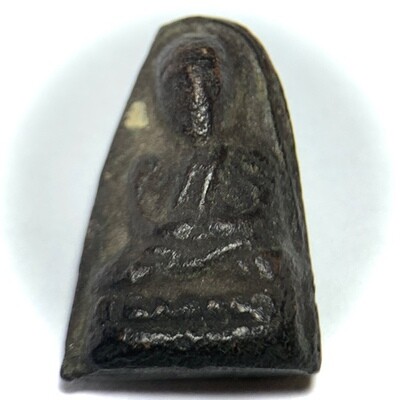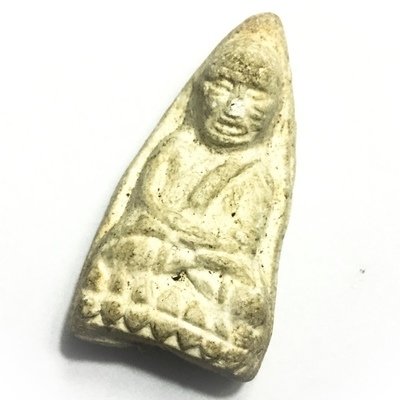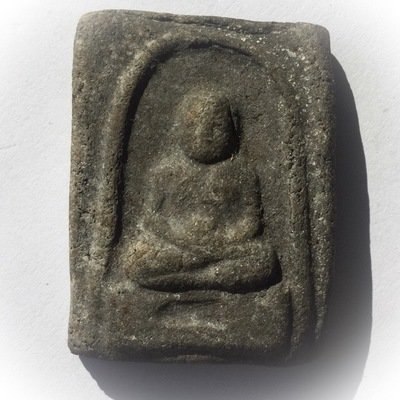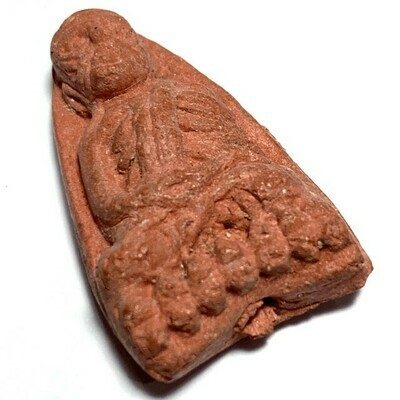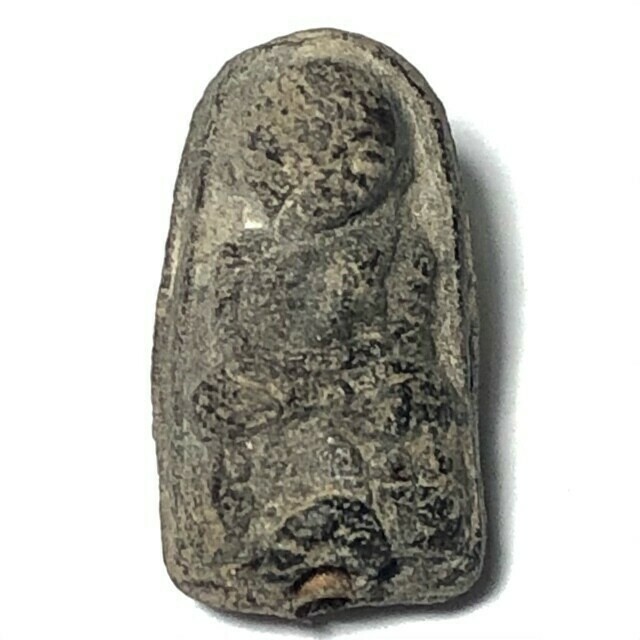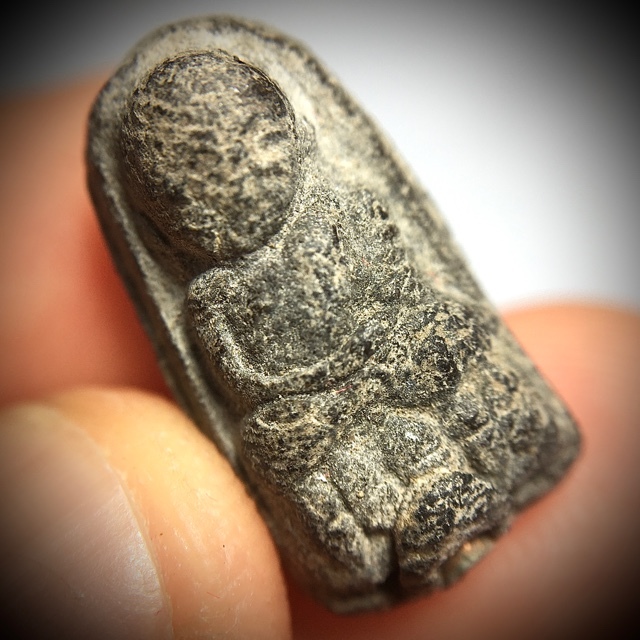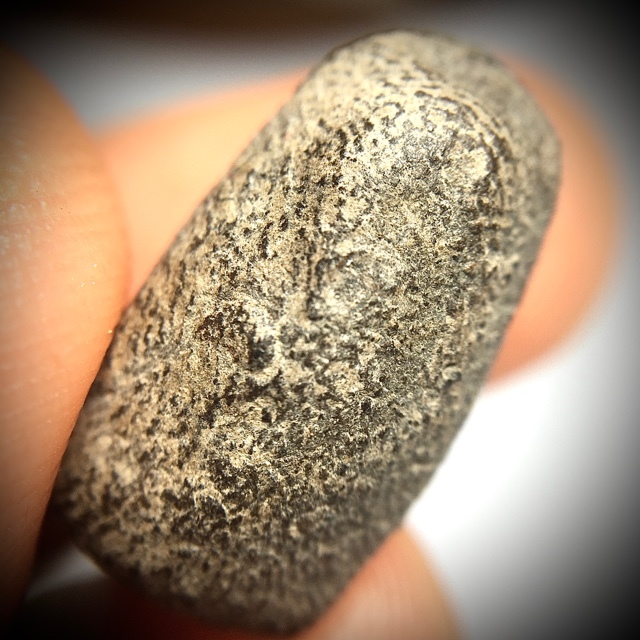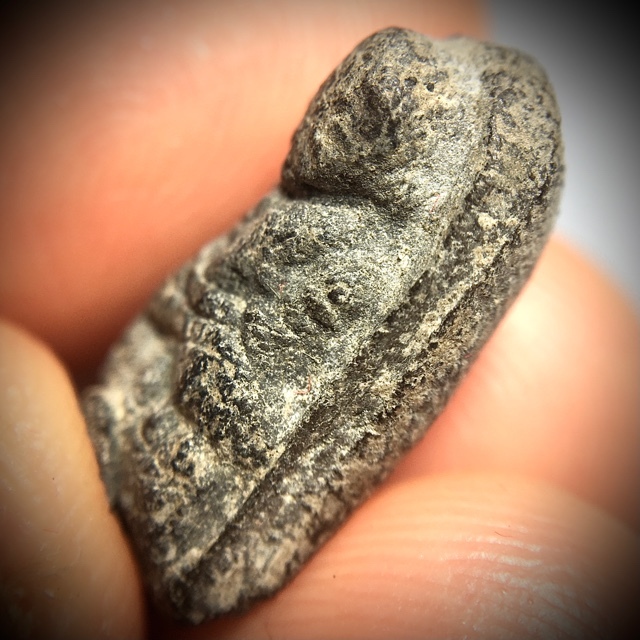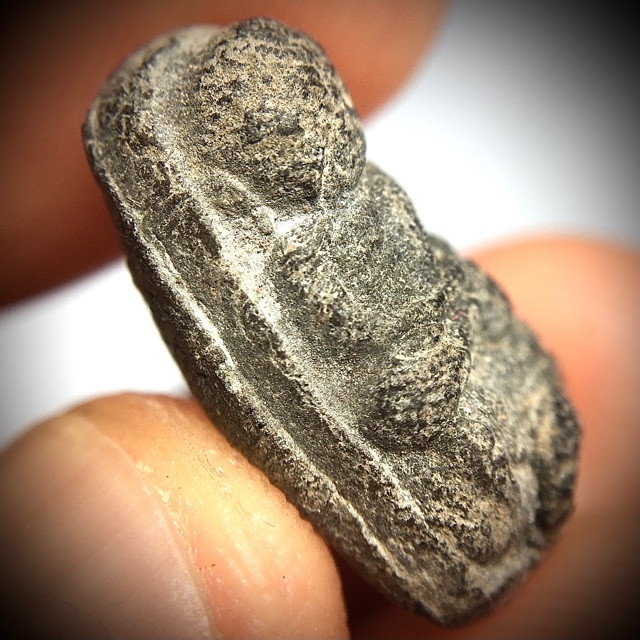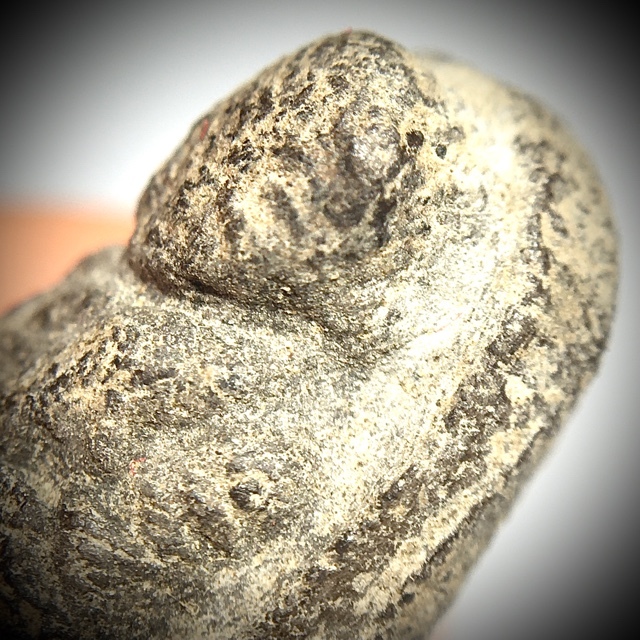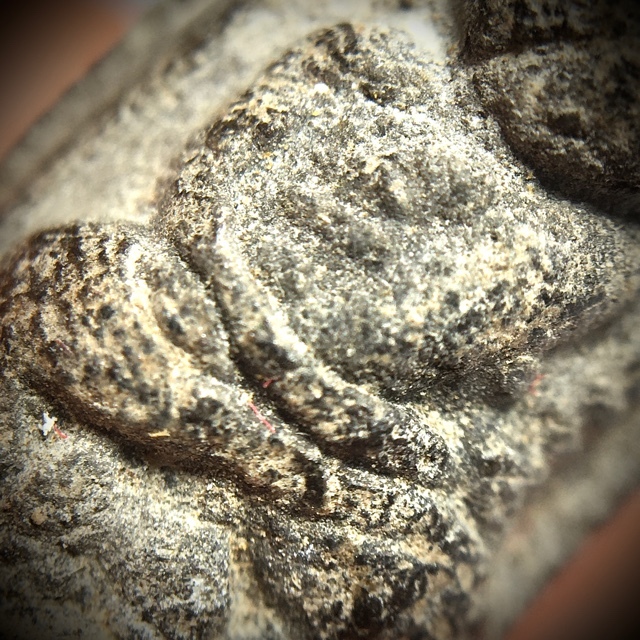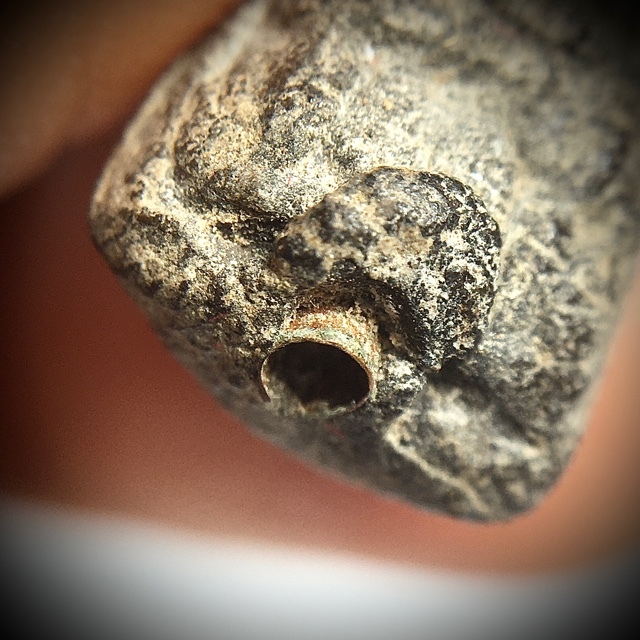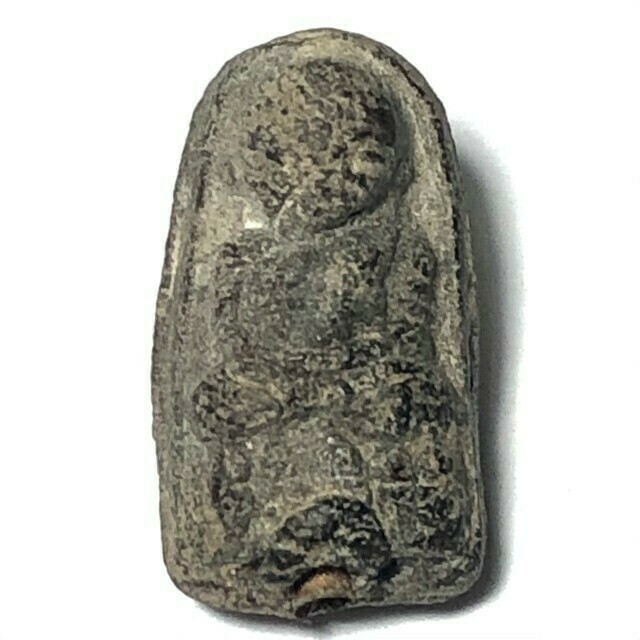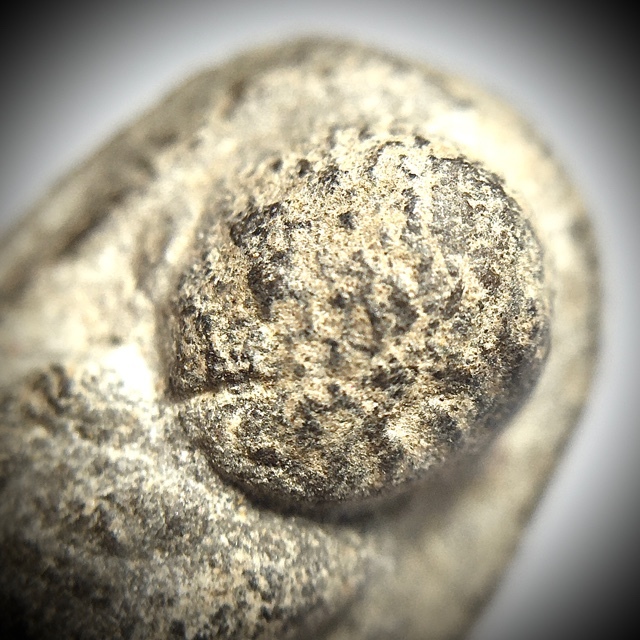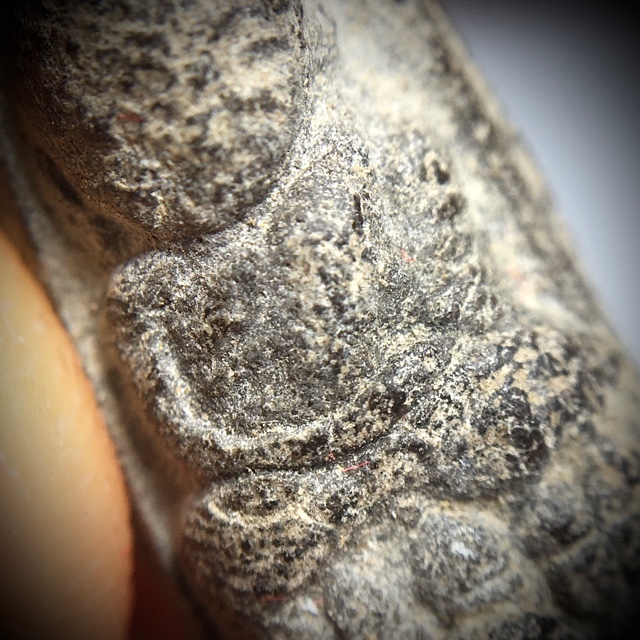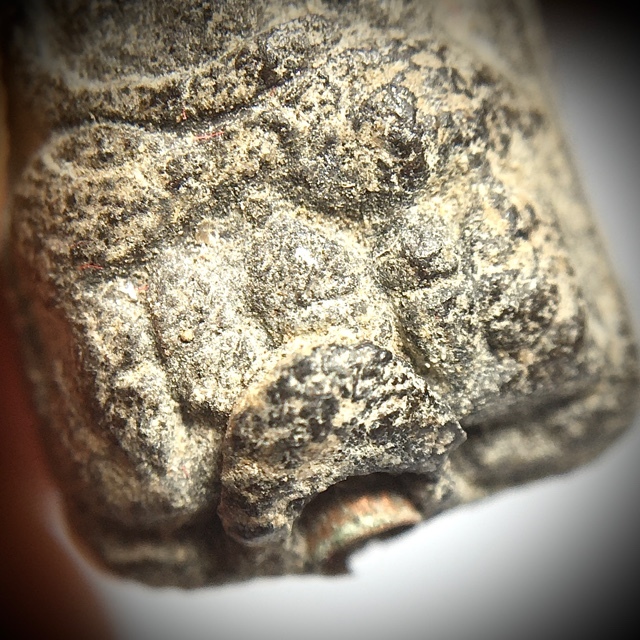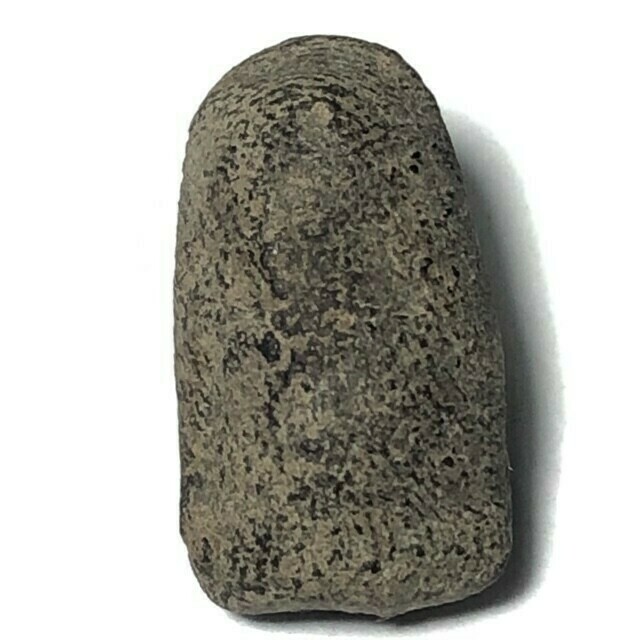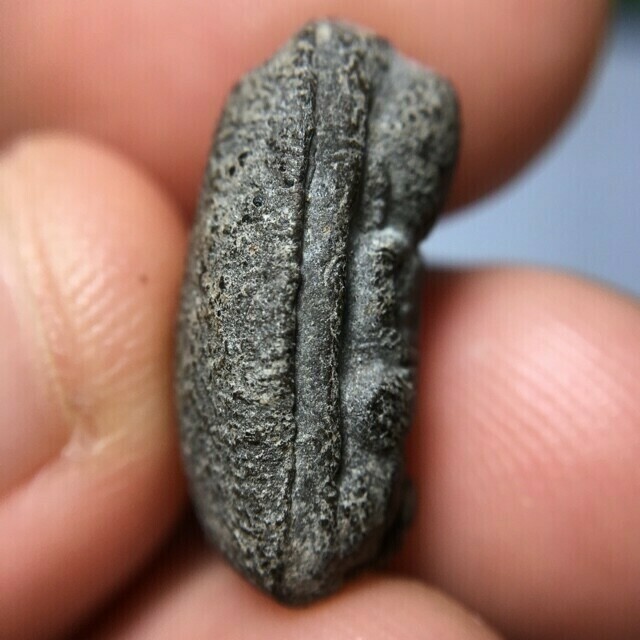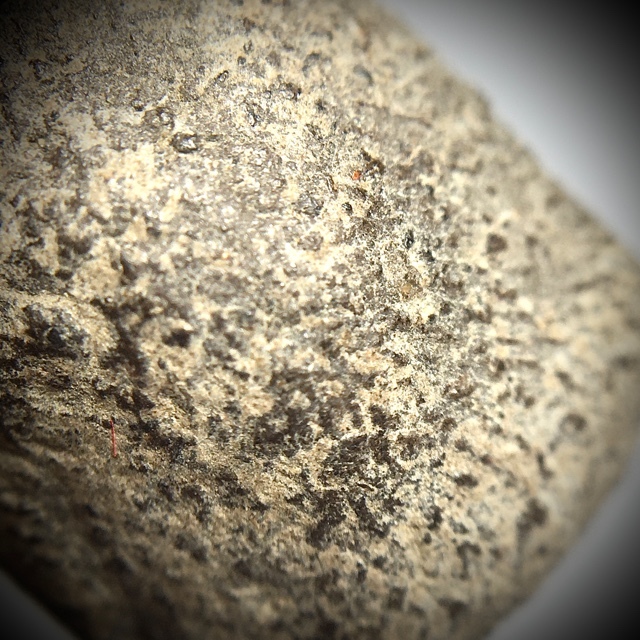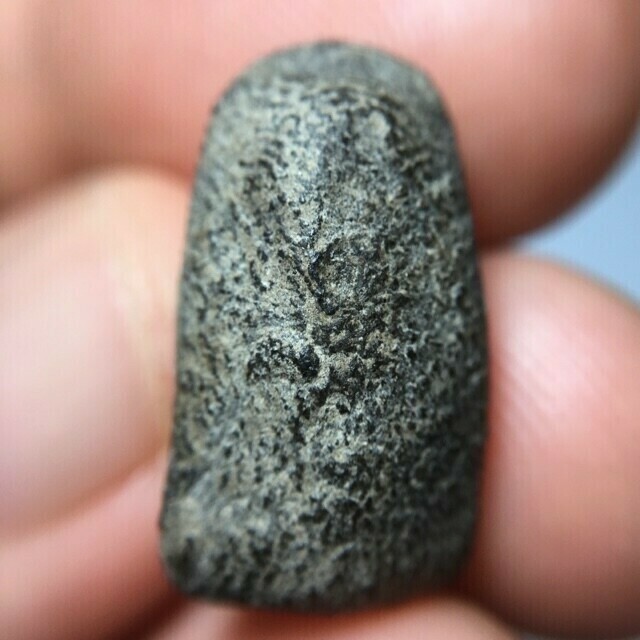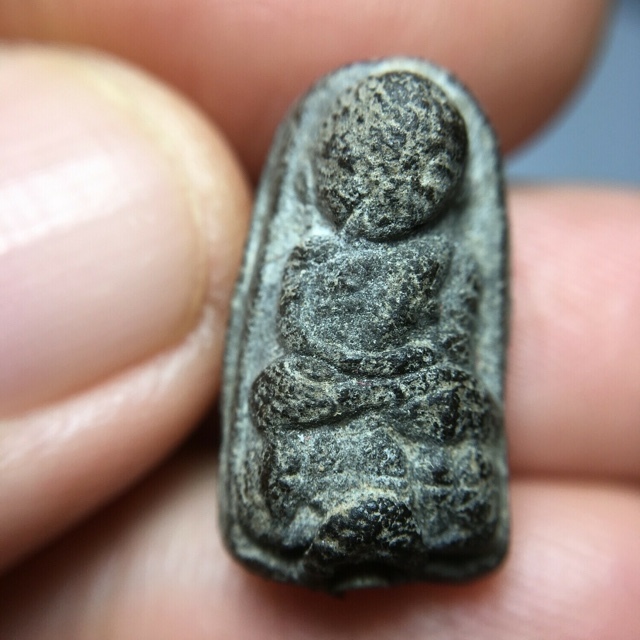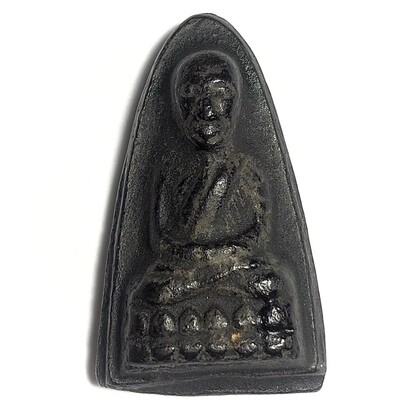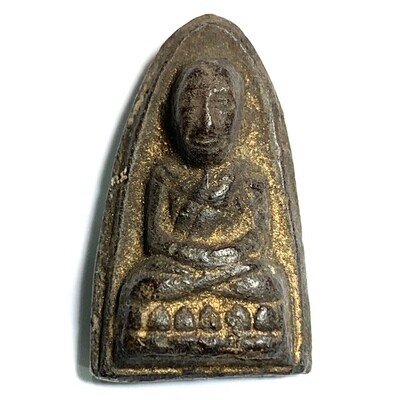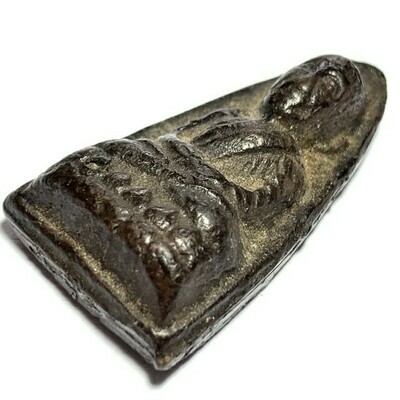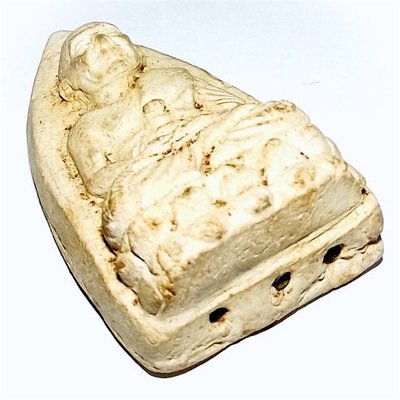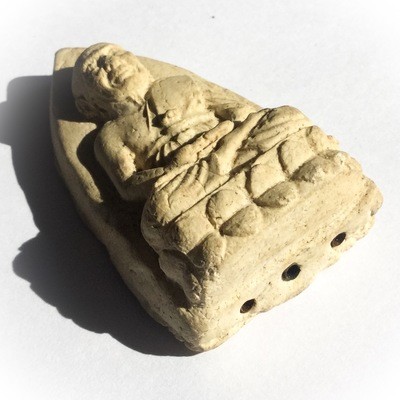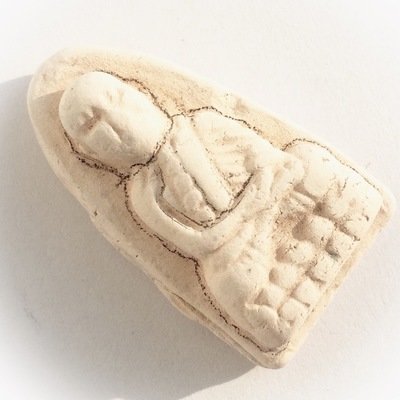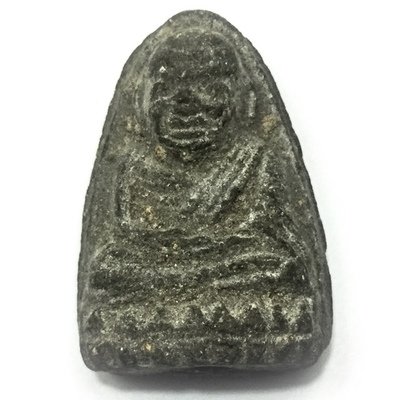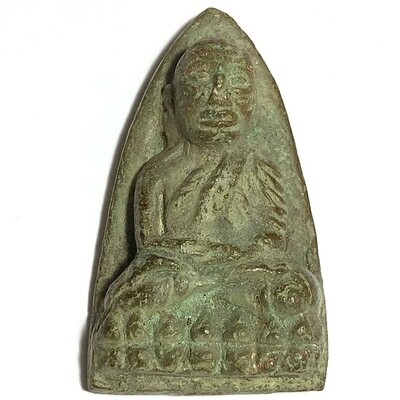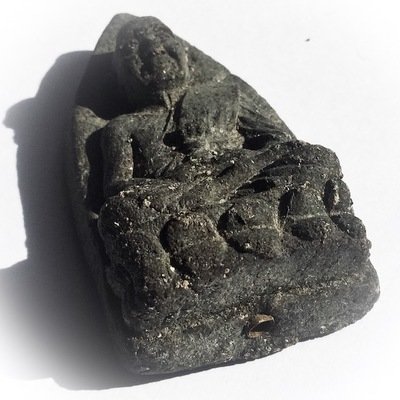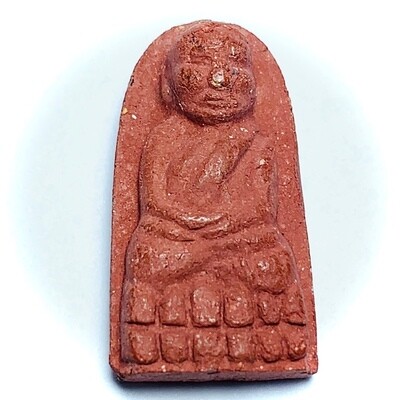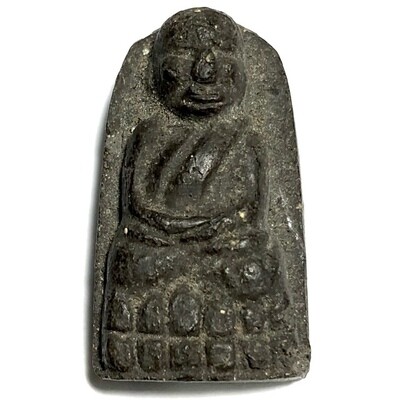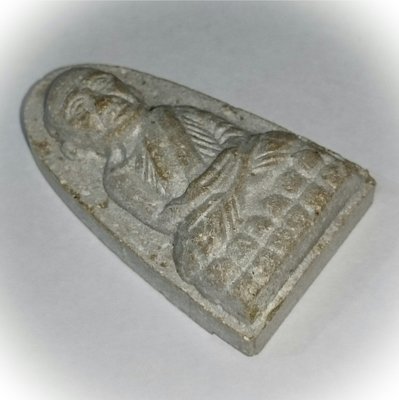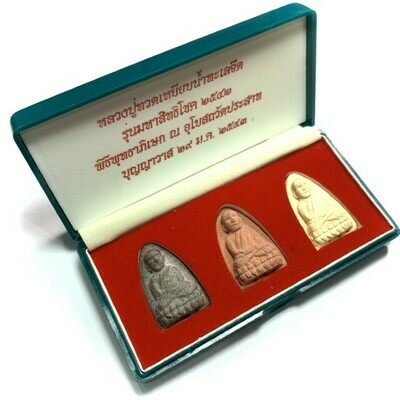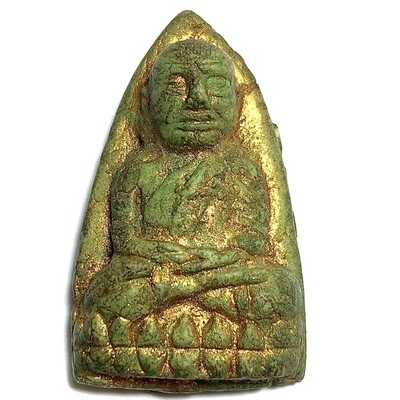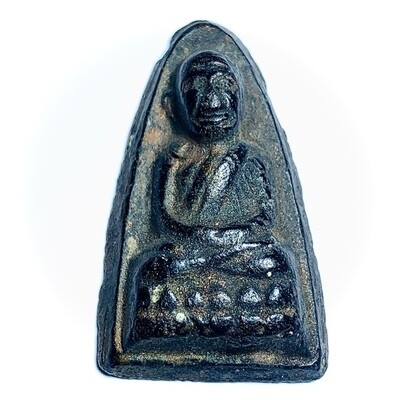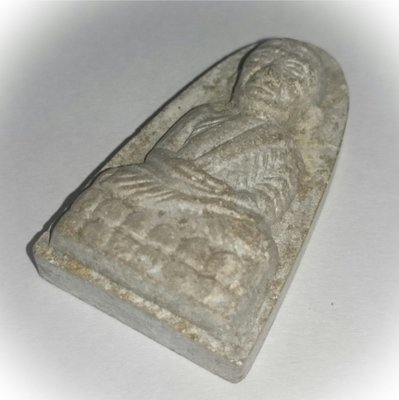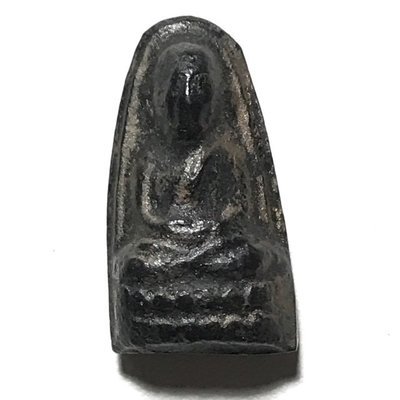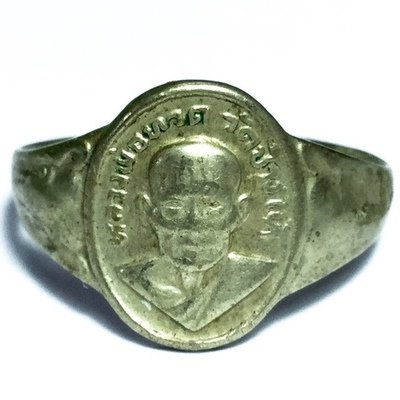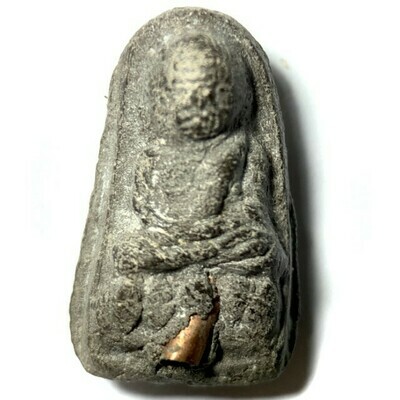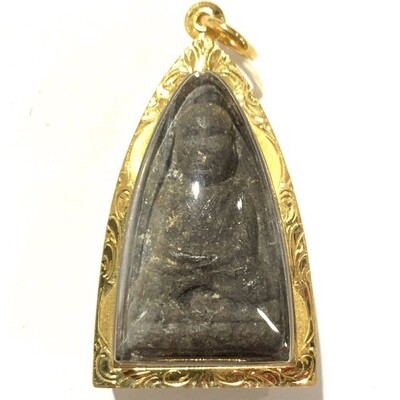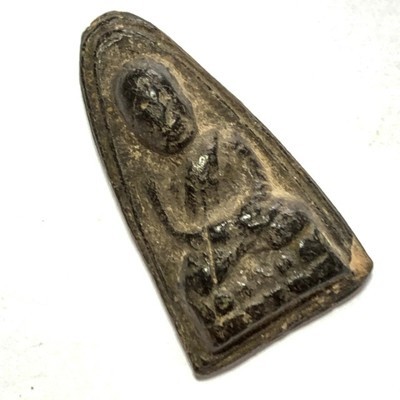Presenting a tiny but powerful and rare classic amulet from one of the Great Khao Or Masters of the 20th Century, Rian Glom Lek Hlang Chedi 2505 BE Nuea Tong Daeng Miniature Guru Monk Coin Por Tan Klai Wajasit
This Sacred amulet of the Great Khao Or Master of Nakorn Sri Tammarat, Master of Wat San Khan and Wat Pratat Noi, is a very rare amulet from Por Tan Klai’s 2505 BE Blessing Ceremony Edition, and is considered a ‘Jaek mae Krua’ type amulet (meaning ‘give to the kitchen maids and temple helpers’), which is suitable not only for men, but due to its miniature size, a perfect amulet for ladies or children to wear.

Rian Glom Lek 2505 BE Por Tan Klai Wajasit Wat Suan Khan
The 2505 BE edition of amulets of Por Tan Klai, is a highly preferred edition, which saw his famous ‘Rian Glom’ round Monk coin amulet with Chakra released, The Rian Glom Lek Hlang Chedi, and the Roop Tai Por Tan Klai Guru Monk Blesséd Photographamulets such as look om chan hmak and ya sen tobacco balls, and sacred powder amulets of various models.
A very rare and highly prized amulet for the devotees of Por Tan Klai to associate with his image and pray to him with a blessed image of the Guru, and the Chedi Relic Stupa on rear face for Buddhanussati and Marananussati. A powerful and Sacred amulet which has passed through the hands of the Guru and been blessed by him.
Por Tan Klai was one of the Top Guru Master Monks of the Last Century, and is considered one of the Four Great Masters of the Previous Generation of Lineage Masters of the Khao Or Southern Sorcery Lineage.
Kata Bucha Por Tan Klai
Pra Luang Por Tuad Pim Lek Fang Takrut Narai Plaeng Roop 2514 BE Rare Masterpiece Amulet Ajarn Nong Wat Sai Khaw
Pra Luang Por Tuad Fang Takrut Narai Plaeng Roop; Ajarn Nong's World Famous Kong Grapan Chadtri amulet, the Sacred Powder Pra Luang Phu Tuad in Pim Lek small version, with Takrut Narai Plaeng Roop inserted into the base, released in 2514 BE.
This most highly acclaimed amulet, is now a Master Class Amulet of Extreme rarity, and famed for its authentic power of Kong Grapan Chadtri and Klaew Klaad protective magic, and power to improve success in life, and bring auspicious Karma to the devotee.
The image of Luang Por Tuad, especially those made by lineage masters of the Wat Pako/Wat Chang Hai Lineage Masters, and their Wicha Inheritors are extremely preferred and collected by Devotees all around South East Asia. It is said by devotees of Luang Por Tuad, that just his image, or even to think of him, can bring immensely powerful blessings in themselves, but the amulets blessed by the uninterrupted Lineage Master descendants of Luang Por Tuad, almost all stand honored in the halls of historical fame in the world of Thai Buddhist Magical Amulets.
Pra Luang Por Tuad amulets of Pra Ajarn Nong of Wat Sai Khaw belong to the Dtamra of Luang Por Tuad Amulets of the Wat Chang Hai and Khao Or Magical Lineages, and enjoy inclusion in the Category of Pra Niyom Master Class Amulets of this Genre.
The most famous of all Takrut by Ajarn Nong, is the Takrut Narai Plaeng Roop, which was so successful with Devotees, that it became his trademark. He made the Takrut as a single item, usually inserted into silver or brass bullet shells or engraved casings, and inserted into amulets, such as this Pra Luang Por Tuad early 2514 edition, and the first edition Takrut Narai Plaeng Roop Master Series. Especially in the Vietnam War, the Soldiers who had received Amulets or Takrut from Ajarn Nong, all came home safely without one single exception, and many returned with tales of miraculous escapes from death, attributed to the magic of Ajarn Nong's amulets.
The Takrut Narai Plaeng Roop was made both with real bullet shells, and also in a decorative case version made in bullet shell shape, and inserted into amulets, which were made once all bullet shells were depleted, but devotees still called for more Takrut.
Kata Bucha Luang Por Tuad
Na Mo Potisadto Aakandtimaaya Idti Pakawaa
Both versions of Takrut, ended up becoming equally popular. As to his Pra Luang Por Tuad amulets, their legend has an even longer history with Ajarn Nong, and is the amulet which of course first caused his magical powers to come to light, as well as his close psychic connection with LP Tuad of Wat Chang Hai, and his Kroo Ba Ajarn Luang Por Tim (Wat Chang Hai). Ajarn Nong released various editions over the years of Pra LP Tuad, all of which are niche collector items and considered to possess true magical power, and the invocations of Luang Por Tuad imbued within them through Lineage Transmission.
There are so many tales of Devotees encountering Miracles and life saving magic, that the legend of his Takrut Narai Plaeng Roop, and his Luang Por Tuad amulets, follow him like his own shadow. It is said that Ajarn Nong began to make and hand out Takrut Tone amulets around 2496 BE, which he would hand out to his close disciples.
The Takrut Narai Plaeng Roop
The very first Takrut were made from small sheet of Iron, and were small in size. Some time later, some Looksit brought some gun shells to use for Takrut making. These Takrut were varied sizes depending on what kind of bullet shells were available. This edition gained much fame and legendary status for the many life saving tales from those who possessed one.
Ajarn Nong's Takrut are famous also for their Puttakun power to change bad luck back into good luck, and to transform fate. After he began to make bullet shell Takruts, his magic also became known for powerful ‘Maha Ud’ (Gun Stopper) and ‘Klaew Klaad’ (Evasion of Danger).
Whenever LP Nong would hand out one of these Takrut, he would say ” this is for protection, if someone thinks to harm you, you, they will not be able to find you, and those who try to harm you, will encounter their own demise.
The letter stamped on the end of each individual Takrut varies greatly through the whole alphabet, depending on the source, for indeed, many different sources (devotees) donated a constant flow of bullet shells and metallic tubes for the production of this series. The Wicha Narai Plaeng Roop used for Ajarn Nongs Takruts is an Ancient Wicha, which is mentioned in the Dtamra Saiyasart as being a Wicha which has immense power, like that of Pra Narai transforming.
It contains a multitude of different blessings. The Wicha of making a Takrut with the image of Pra Narai is a Wicha which not many people know how to perform, which makes this type of Takrut extremely rare to find. To perform the spell properly, it is necessary to Master the ‘Wicha Dtang Agarn 32′ and the ‘Wicha Riak Roop Riak Nam’, as is usual with all spells that use the image of a being, Himapant animal or Deity.
But it is much more difficult to force and contain a magical image of Pra Narai using incantation, than it is to contain and subdue a lower Deity or Himapant animal. This is therefore the reason why there are hardly any Masters at all who can enforce this type of magic spell.
The usual and more common method for applying this Wicha, is to use a Yant design which represents the basic principles of Pra Narai transforming, or to use a Kata instead. The image of Pra Narai is simply too powerful for most people to be able to control and force into the Takrut.
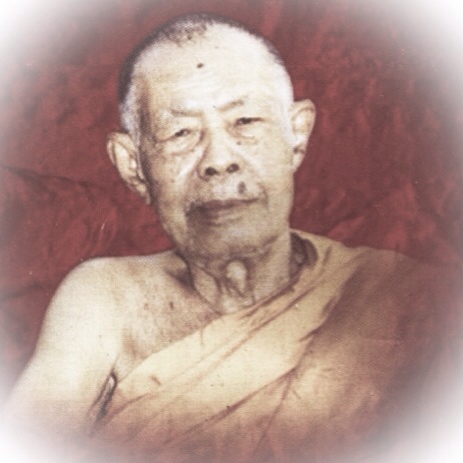
There is a story recorded in the Biography of Somdej Pra Puttajarn (Dto) Prohmrangsri (Wat Rakang Kositaram) written by Maha Amamat Praya Tip Gosaa (Ajarn Sorn Lohanant) and Pra Kroo Plad Maha Thaeranuwatra (Maha Pae).
The Biography was published to celebrate 200 years of the Ratanakosin Era. In the story it tells that, as King Rama 4 called upon Somdej Dto to accept a dignified status, Somdej Dto fled to the forest, and hid from the responsibility. He did not wish to have status, rather wished to be a simple monk. His Majesty sent envoys out around the country to find Somdej Dto, but however hard they searched, he could not be found.
Somdej Dto used a Wicha to change his face so that those who knew him would not recognize him if the saw him, and he was only able to be found, because he presented himself to the Gamnan (Marshal) of Ban Phai, who took him then to Wat Po Chetupon. The wicha Somdej Dto used to change his appearance,is the Wicha Pra Narai Plaeng Roop.
Ajarn Nong would always tell his Looksit who received the Takrut Pra Narai Plaeng Roop, that they would be able to avoid dangers. The story of Somdej Dtos disappearance demonstrates the power of this Wicha, for it is much harder for a Nationally famous Monk whose portrait everyone knows to hide than a normal person, proving how the Wicha Narai Plaeng Roop can make even a well known face able to avoid being noticed.
Legend tells that LP Nong received his special form of the Wicha Pra Narai Plaeng Roop one evening, as a tree spirit, who appeared to him, dressed as in ancient times in a red ‘Pha Sabai’ robe. She appeared in front of the pillars of the Kuti hut of Ajarn Nong, and showed him the Wicha for making Takrut Tone, how to make the Agkhara inscriptions and Kata incantations for empowering the Takrut with the Pra Narai Plaeng Roop spell. She then told him her name, which was ‘Mae Nang Jantr’.
He was told by the Mae Nang Jantr that she is a Deva who lives on the peak of Mount Kalakiree, and is related to Luang Por Sitti Chai, the ex Abbot of Wat Sai Khaw. He said that the Mae Nang Jantr Deva wanted to collaborate and join in to make Merit, by helping Ajarn Nong complete the building of his Kuti, and also to enable Ajarn Nong to become Abbot of Wat Sai Khaw. So she showed him how to master the Wicha Takrut When Ajarn Nong awoke from the Nimitta, he felt as if he had been speaking with a real person, and could remember every detail of the dream perfectly.
Ajarn Nong Thus believed everything that had occurred during his Nimitta Vision, including the fact that this Wicha for Takrut is authentic.The versions of Takrut Narai Plaeng Roop which were made with bullet shells, were ususally also filled with sacred items. The main sacred item Ajarn Nong would insert into the Takrut, is a kind of wood called ‘Mai Luang Por Thuad’, which the Deva Mae Nang Jantr told Ajarn Nong how to find, and take from Mount Kalakiree. No one really knows what kind of wood it is, nor what it looks like, because Ajarn Nong would lay out a rule that it is forbidden to break the seal of a bullet Takrut and open it. If such a thing were to happen, the Takrut would be immediately ineffective and never again usable.
Kata Bucha Takrut Narai Plaeng Roop
Idtibpiso Wi-Sae-Sae-I
I-Sae-Sae Put-Ta-Naa-Mae-I
I-Mae-Naa Putta-Dtang-So-I
I-So-Dtang-Putta-Bpi-Dti-I
Method for giving offerings and chanting in worship to Pra Narai (Vishnu), for the Takrut within the amulet;
Making Offerings to Pra Narai (Vishnu)
Offerings to Vishnu, and Vishnu Riding on Garuda Deity, should include the following Gratong (a kind of crown ornamental offering made from banana leaf), with puffed rice and spicy foods (2 or 3 kinds), sweetmeats and puddings (5 kinds), 3 kinds of fruits (banana, coconut and sugar cane is traditional), milk, butter (ghee), Kaprao leaf (Thai holy basil, known as Tolasee in India), white and green seeds, red beans in coconut milk, perfumed offerings, 7 small green flags (pennant), 3 pieces of cloth (green red and yellow), a clay doll (stone, cement or carved wood), and some figurines of cows, horses, elephants and buffaloes.
Incense, candles and flowers are of course indispensable. In addition, you could add water to drink in a glass, and perfumed pure water inside a conch shell for bathing.
Kata Pra Narai Song Krut – Vishnu Kata (For all forms of Vishnu Deva including Vishnu on Garuda)
Om Pra Naaraayana Raacha Haradti Tisathidtaaya Ubpaatawadtaaya Jadt-Dtu Krudhaa Pahananaaya Haradti Tisatidtaaya Aakajchandtu Punchadtu Khibp-bpaya Dtu Wibp-bpaya Dtu Sawaaha Sawaahaaya Sappa Ubpaatawa Winaasaaya Sappa Ubpaatawa Winaasaaya Sappa Andtaraaya Sukh-khawattago Ho-odtu Aayu Wanna Sukha Palang Amhaagang Ragkhandtu Sawaaha Sawaahaa Sawaahaaya
Chant the Kata then blow it into the offerings or into the amulet if raising over your head to wear for the day. In that case, raise the amulet between the palms of your hands in praying posture at your forehead and chant 3 times if making Bucha offerings and blow into the offerings. After the first time you perform the ‘Piti Buang Suang’ (offerings To Narai – place the amulet on the altar in the house), you must only chant once per day when putting the amulet on – chant the Kata, then blow your breath into the amulet. Do this once a day for however many years you have been living, plus one day extra. this will increase your lifespan and healthy lifetime, and in addition will make the power of Pra Narai make even more powerful blessings come to you.
Visnu Kayatri
Om Naaraayan Witamhae Waasutaewaaya Timhi Dtanno Sutas Bparijotyaadta
Narai Kayatri
Om Narai Witamhae Saesasaayinae Timhi Dtanno Sutas Bparijotyaadta
Kata Khor Porn (Ask for Blessings)
Om Haradti Tisa Naaraayana Taewadtaa Sa Ha Ka Na Bpari Waaraaya Aakajchandtu Bparigunchadtu Sawaaha Sawaahaaya
Om Sappa Ubpatawa Sappa Tud-t Sappasoga Sappa Roka Sappa Paya Sappa Ubpattawa Sappa Sadtruu Winaasaaya Bpamujjandti Om Naaraayana Taewadtaa Sataa Ragkadtu Sawaaha
